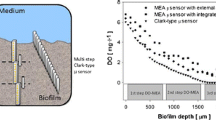Abstract—
A method is proposed for controlling the wettability of the surface of a fluorinated material and for controlling its biofouling by introducing modified nanodiamonds into the structure. The optimal modification conditions were determined by means of a set of methods based on the example of a molecular oxygen sensor. They do not lead to a change in other functional properties of the material, such as the calibration curve and response time. In vitro tests have shown that a small amount of aminated nanodiamonds gives the surface bactericidal properties, but with a high content, improved adhesion of the biomaterial is observed due to a decrease in hydrophobicity. Long-term in situ tests under conditions simulating a bioreactor with actively growing biomass showed an almost complete absence of biological fouling of the modified material and revealed a significant fouling of the sensor from traditionally used polystyrene.








Similar content being viewed by others
REFERENCES
O. S. Wolfbeis, Bioessays 37, 921 (2015). https://doi.org/10.1002/bies.201500002
A. P. Antropov, A. V. Ragutkin, P. V. Melnikov, et al., IOP Conf. Ser.: Mater. Sci. Eng. 289, 012031 (2018). https://doi.org/10.1088/1757-899x/289/1/012031
P. V. Melnikov, A. O. Naumova, A. Yu. Alexandrovskaya, and N. K. Zaitsev, Nanotechnol. Russ. 13, 602 (2018). https://doi.org/10.1134/S1995078018060083
P. V. Melnikov, A. E. Kozhukhova, A. O. Naumova, et al., Int. J. Eng. Trans. B: Appl. 32, 641 (2019). https://doi.org/10.5829/ije.2019.32.05b.03
K. H. Chae, D. W. Hong, M. K. Lee, et al., Sens. Actuators, B 173, 636 (2012). https://doi.org/10.1016/j.snb.2012.07.086
J. M. Bolivar, S. Schelch, T. Mayr, et al., ACS Catal. 5, 5984 (2015). https://doi.org/10.1021/acscatal.5b01601
P. Zhu, W. Meng, and Y. Huang, RSC Adv. 7, 3179 (2017). https://doi.org/10.1039/C6RA26409C
A. A. Zharov, I. B. Konovalova, and E. V. Polunin, Russ. Chem. Bull. 65, 233 (2016). https://doi.org/10.1007/s11172-016-1290-6
V. I. Sokolov, I. O. Goriachuk, S. I. Molchanova, et al., Russ. Chem. Bull. 68, 559 (2018). https://doi.org/10.1007/s11172-019-2454-y
M. S. Piskarev, A. B. Gilman, N. A. Shmakova, et al., High Energy Chem. 47, 251 (2013). https://doi.org/10.1134/S001814391305010X
V. N. Mochalin, I. Neitzel, B. J. M. Etzold, et al., ACS Nano 5, 7494 (2011). https://doi.org/10.1021/nn2024539
B. V. Spitsyn, J. L. Davidson, M. N. Gradoboev, et al., Diamond Relat. Mater. 15, 296 (2006). https://doi.org/10.1016/j.diamond.2005.07.033
G. V. Sakovich, A. S. Zharkov, and E. A. Petrov, Nanotechnol. Russ. 8, 581 (2013). https://doi.org/10.1134/S1995078013050121
G. N. Bondarenko, M. M. Ermilova, M. N. Efimov, et al., Ross. Nanotekhnol. 11 (11–12), 41 (2016).
T. S. Kurkin, A. N. Ozerin, E. P. Tikunova, A. S. Kechek’yan, E. K. Golubev, A. K. Berkovich, and V. Yu. Dolmatov, Nanotechnol. Russ. 10, 878 (2015). https://doi.org/10.1134/S1995078015060063
V. S. Bondar’, I. I. Gitel’zon, A. P. Puzyr’, et al., Ross. Nanotekhnol. 3 (5–6), 42 (2008).
O. Mogilnaya, N. Ronzhin, K. Artemenko, et al., Biocatal. Biotransform. 37, 97 (2019). https://doi.org/10.1080/10242422.2018.1472586
A. A. Isakova, A. V. Safonov, A. Yu. Alexandrovskaya, et al., Prot. Met. Phys. Chem. Surf. 53, 220 (2017). https://doi.org/10.1134/S2070205117020137
M. Quaranta, S. M. Borisov, and I. Klimant, Bioanal. Rev. 4, 115 (2012). https://doi.org/10.1007/s12566-012-0032-y
N. K. Zaitsev, V. I. Dvorkin, P. V. Melnikov, et al., J. Anal. Chem. 73, 102 (2018). https://doi.org/10.1134/S1061934818010136
N. K. Zaitsev, P. V. Melnikov, V. A. Alferov, et al., Proc. Eng. 168, 309 (2016). https://doi.org/10.1016/j.Proeng.2016.11.203
T. Tolker-Nielsen, U. C. Brinch, P. C. Ragas, et al., J. Bacteriol. 182, 6482 (2000). https://doi.org/10.1128/JB.182.22.6482-6489.2000
S. J. Pamp and T. Tolker-Nielsen, J. Bacteriol. 189, 2531 (2007). https://doi.org/10.1128/JB.01515-06
T. M. Buttke, J. A. Mccubrey, and T. C. Owen, J. Immunol. Methods. 157, 233 (1993). https://doi.org/10.1016/0022-1759(93)90092-l
T. Mosmann, J. Immunol. Methods. 65, 55 (1983). https://doi.org/10.1016/0022-1759(83)90303-4
J. P. Adkins, L. A. Cornell, and R. S. Tanner, Geomicrobiol. J. 10, 87 (1992). https://doi.org/10.1080/01490459209377909
T. Burleson, N. Yusuf, and A. Stanishevsky, J. Achievem. Mater. Manuf. Eng. 37, 258 (2009).
X. Wang and O. S. Wolfbeis, Chem. Soc. Rev. 43, 3666 (2014). https://doi.org/10.1039/C4CS00039K
M. Ivanova, E. Burtseva, V. Ivanova, et al., MRS Proc. 1452 (2012). https://doi.org/10.1557/oPl.2012.1226
L. Qian, Y. Guan, B. He, et al., Polymer 49, 2471 (2008). https://doi.org/10.1016/j.Polymer.2008.03.042
E. Escamilla-García, A. G. Alcázar-Pizaña, J. C. Segoviano-Ramírez, et al., Int. J. Microbiol. 2017, 5924717 (2017). https://doi.org/10.1155/2017/5924717
Funding
The study was supported by the Russian Science Foundation (grant no. 17-79-10439).
Author information
Authors and Affiliations
Corresponding author
Rights and permissions
About this article
Cite this article
Aleksandrovskaya, A.Y., Melnikov, P.V., Safonov, A.V. et al. The Effect of Modified Nanodiamonds on the Wettability of the Surface of an Optical Oxygen Sensor and Biological Fouling During Long-Term in Situ Measurements. Nanotechnol Russia 14, 389–396 (2019). https://doi.org/10.1134/S1995078019040025
Received:
Revised:
Accepted:
Published:
Issue Date:
DOI: https://doi.org/10.1134/S1995078019040025




